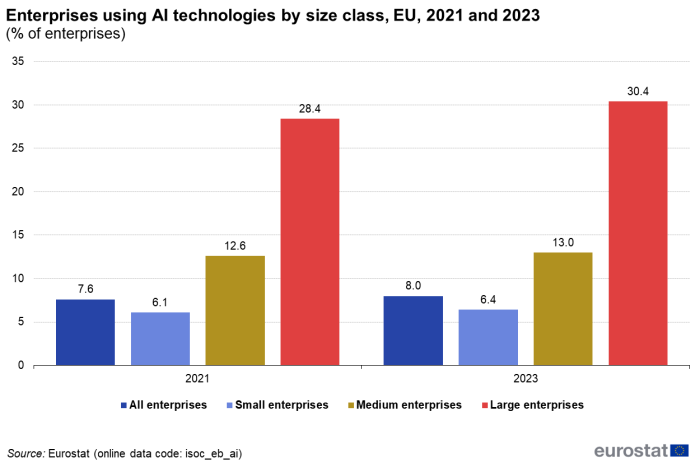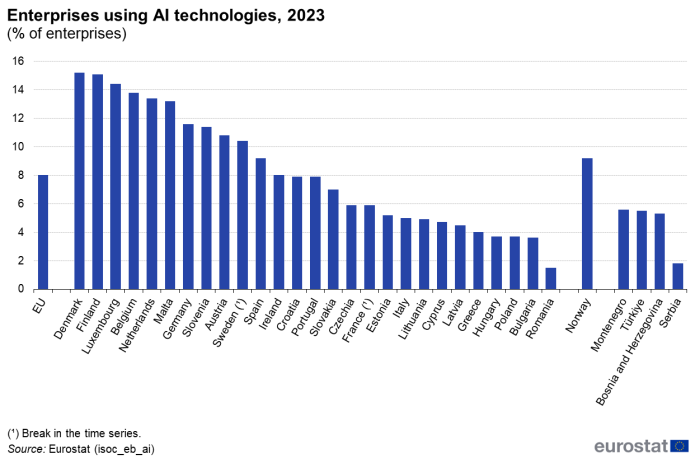Enterprises using artificial intelligence technologies
In 2023, 8 % of enterprises in the EU, with 10 or more employees and self-employed persons, used at least one of the following AI:
- technologies analysing written language (text mining)
- technologies converting spoken language into a machine-readable format (speech recognition)
- technologies generating written or spoken language (natural language generation)
- technologies identifying objects or people based on images (image recognition, image processing)
- machine learning (e.g. deep learning) for data analysis
- technologies automating different workflows or assisting in decision-making (AI based software robotic process automation)
- technologies enabling machines to physically move by observing their surroundings and taking autonomous decisions.
Compared with 2021, the use of AI technologies increased slightly by 0.4 percentage points (Figure 1).
As shown in Figure 1, large enterprises used AI more than small and medium enterprises. In 2023, 6.4 % of small enterprises, 13 % of medium enterprises and 30.4 % of large enterprises used AI. This difference might be explained, for example, by the complexity of implementing AI technologies in an enterprise, economies of scale (i.e. enterprises with larger economies of scale can benefit more from AI) or costs (i.e. investment in AI may be more affordable for large enterprises).
(% of enterprises)
Source: Eurostat (isoc_eb_ai)
Comparing enterprises using at least one AI technology among EU countries (Figure 2) shows that the share of enterprises using AI ranged between 1.5 % and 15.2 %. The highest share was recorded in Denmark (15.2 %), followed by Finland (15.1 %), and Luxembourg (14.4 %), while the lowest shares were recorded in Romania (1.5 %), Bulgaria (3.6 %), and Poland and Hungary (both 3.7 %).
As shown in Figure 3, in some economic activities AI is used a lot more than in others. This might indicate that AI is more relevant for certain activities. In 2023, the information and communication sector (with 29.4 %) and professional, scientific and technical service activities (with 18.5 %) stood out with the highest share of enterprises that used AI. In all other economic activities, the share of enterprises using AI was below 10 %. This ranged from 8.8 % (electricity, gas steam, air conditioning and water supply) to 3.2 % (construction).
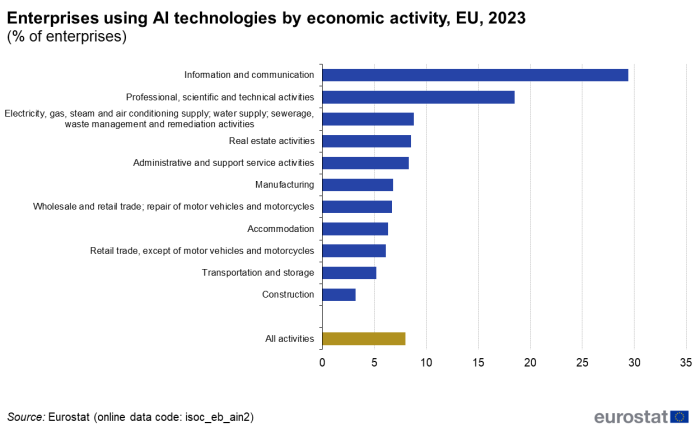
(% of enterprises)
Source: Eurostat (isoc_eb_ain2)
Types of AI technologies used
EU enterprises used different types of AI technologies. As presented in Figure 4, there was no predominant AI technology. The AI technologies used slightly more often were AI technologies automating different workflows or assisting in decision-making (e.g. AI-based software robotic process automation). In 2023, these AI technologies were used by 3 % of enterprises. AI technologies analysing written language (i.e. text mining) followed with 2.9 % of enterprises. Machine learning (e.g. deep learning) for data analysis, technologies converting spoken language into a machine-readable format (speech recognition), technologies identifying objects or persons based on images (image recognition, image processing) and technologies generating written or spoken language (natural language generation) were each used by between 2.6 % and 2.1 % of enterprises. Technologies enabling machines to physically move by observing their surroundings and taking autonomous decisions (e.g. self-driving vehicles) were used by less than 1 % of enterprises (0.9 %).
Although there was no predominant AI technology used by all enterprises, Figure 4 shows a different situation when looking at the size of the enterprises, in particular large enterprises. AI technologies automating different workflows or assisting in decision-making, with 16.4 %, were the most used technologies, followed by machine learning for data analysis (14.6 %). The least used AI technologies were those enabling physical movement of machines via autonomous decisions based on observation of surroundings (7.0 %).
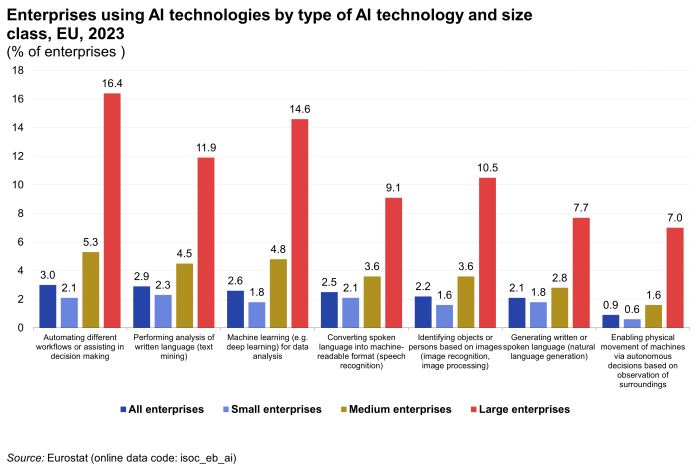
(% of enterprises)
Source: Eurostat (isoc_eb_ai)
Table 1 presents the different types of AI technologies used in different economic activities. In the information and communication sector, where the highest share of enterprises using AI was recorded, the most used AI technologies were machine learning for data analysis (16.2 %), followed by text mining (14.2 %). In professional, scientific and technical service activities, speech recognition was used slightly more than other AI technologies (7.2 %), followed by text mining and AI technologies automating different workflows or assisting in decision-making (both 6.9 %). In all other activities, the shares of enterprises using specific AI technologies ranged from less than 1 % to 3.9 %.
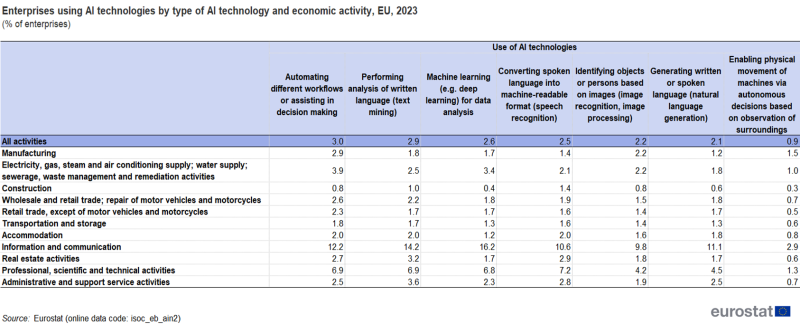
(% of enterprises)
Source: Eurostat (isoc_eb_ain2)
Purpose of using AI software or systems
EU enterprises used AI software or systems for different purposes. In 2023, 26.2 % of enterprises using AI technologies used these software or systems for ICT security (e.g. using machine learning for detecting and preventing cyber-attacks) and 25.8 % for accounting, controlling or finance management. AI software or systems for logistics were used the least by 9.6 % of enterprises using AI technologies (Figure 5).
The purposes for which enterprises used AI software and systems differed depending on their size. The biggest difference between small and large enterprises was recorded for those that used AI software or systems for ICT security (47.9 % large enterprises, 20.5 % small enterprises), followed by those which used them for production processes (39.4 % large enterprises, 22.3 % small enterprises) and those that used them for logistics (20.6 % large enterprises, 7.5 % small enterprises) (Figure 5).
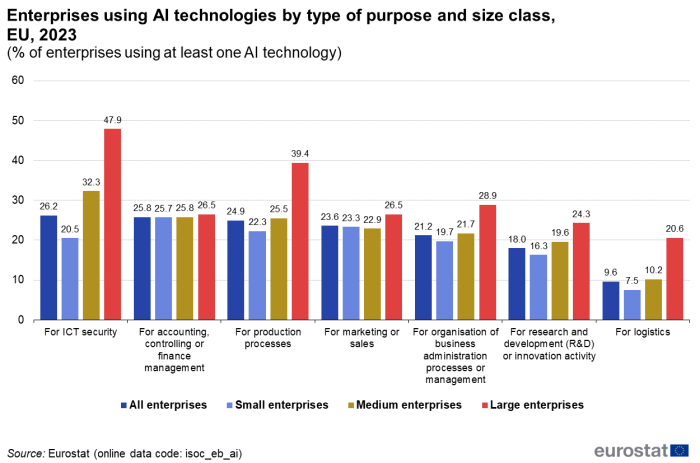
(% of enterprises using at least one AI technology)
Source: Eurostat (isoc_eb_ai)
Enterprises used AI technologies for different purposes depending on the branch of the economy in which they were operating. In the manufacturing sector, AI software or systems were used mostly for production processes (38.2 %), while AI software or systems were mostly used for ICT security in the electricity, gas, steam, air conditioning and water supply sector (37.6 %) and in the information and communication sector (31.6 %). The main use for AI was research and development (R&D) or innovation activity in the information and communication sector (41.3 %). Enterprises mainly used AI software or systems for marketing or sales in the accommodation sector (51.4 %) and in the retail trade sector (41.8 %) (Table 2).
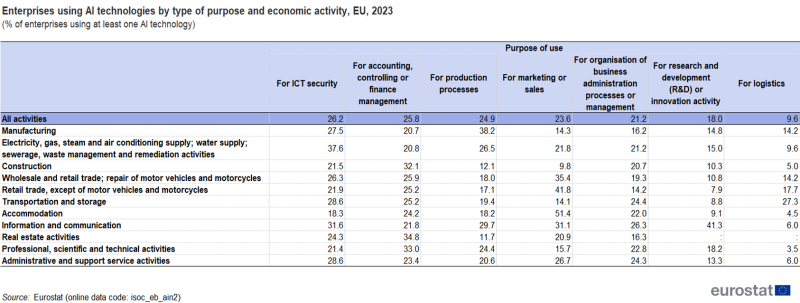
(% of enterprises using at least one AI technology)
Source: Eurostat (isoc_eb_ain2)
Source data for tables and graphs
Data sources
Data presented in this article are based on the results of the 2023 survey on ‘ICT usage and e-commerce in enterprises’. Statistics were obtained from the surveys conducted by National Statistical Authorities in the first months of the year.
In 2023, 150 400 of the 1.47 million enterprises in the EU were surveyed. Of the 1.47 million enterprises, approximately 83 % were small enterprises, 14 % medium and 3 % large enterprises.
Enterprises are broken down by size: small enterprises (10-49 employees and self-employed persons), medium (50-249 employees and self-employed persons) and large (250 or more employees and self-employed persons).
Source data shown as ‘:’ refer to data that are unavailable, unreliable, confidential or not applicable. Unreliable data are included in the calculation of European aggregates. Data presented in this article may differ from the data in the database on account of updates made after the data extractions used for this article. Data in the database are organised according to the survey year.
The observation statistical unit is the enterprise, as defined in the Regulation (EC) No 696/1993 of 15 March 1993. The survey covered enterprises with at least 10 employees and self-employed persons. Economic activities correspond to the classification NACE Revision 2.The sectors covered are manufacturing, electricity, gas and steam, water supply, construction, wholesale and retail trades, repair of motor vehicles and motorcycles, transportation and storage, accommodation and food service activities, information and communication, real estate, professional, scientific and technical activities, administrative and support activities and repair of computers and communication equipment.
Context
In 2019, the new European Commission President, Ursula von der Leyen, described how she wanted the EU to grasp the opportunities presented by the digital age. A Europe fit for the digital age is one of six Commission priorities for the period 2019-2024. Such a digital transformation is based on the premise that digital technologies and solutions should: open up new opportunities for businesses; boost the development of trustworthy technology; foster an open and democratic society; enable a vibrant and sustainable economy; help fight climate change. With this in mind, during February 2020 the European Commission adopted an overarching presentation of the Commission’s ideas and actions for Shaping Europe’s Digital Future, as well as specific proposals in relation to:
• A European strategy for data (COM(2020) 66 final) which seeks to promote the EU as a leading role model for a society empowered by data to make better decisions — in business and the public sector; and
• a White Paper on Artificial Intelligence — A European approach to excellence and trust (COM(2020) 65 final) which supports a regulatory and investment oriented approach with the twin objectives of promoting the uptake of artificial intelligence and addressing the risks associated with certain uses of this new technology.
In 2021, the Digital Compass for the EU’s Digital Decade (COM(2021)118 final), set the EU’s digital targets for 2030 evolving around four cardinal points: skills, digital transformation of businesses, secure and sustainable digital infrastructures, and digitalization of public services.

